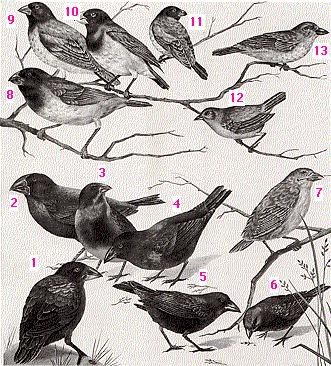 The finches on the Galapagos Islands differ to some extent in habits, color, and plumage, but they differ most in the size and shape of the beaks.
The finches on the Galapagos Islands differ to some extent in habits, color, and plumage, but they differ most in the size and shape of the beaks.The finches numbered 1–7 are ground finches and seek their food on the ground or in low shrubs. Those numbered 8–13 are tree finches and live primarily on insects.
Some finches have stout beaks for eating seeds of one size or another (#2, #3, #6). Others have beaks adapted for eating insects or nectar. One (#7) has a beak like a woodpecker's. It uses it to drill holes in wood, but lacking the long tongue of a true woodpecker, it uses a cactus spine held in its beak to dig the insect out. One (#12) looks more like a warbler than a finch, but its eggs, nest, and courtship behavior is like that of the other finches.
1. Large cactus finch (Geospiza conirostris)
2. Large ground finch (Geospiza magnirostris)
3. Medium ground finch (Geospiza fortis)
4. Cactus finch (Geospiza scandens)
5. Sharp-beaked ground finch (Geospiza difficilis)
6. Small ground finch (Geospiza fuliginosa)
7. Woodpecker finch (Cactospiza pallida)
8. Vegetarian tree finch (Platyspiza crassirostris)
9. Medium tree finch (Camarhynchus pauper)
10. Large tree finch (Camarhynchus psittacula)
11. Small tree finch (Camarhynchus parvulus)
12. Warbler finch (Certhidia olivacea)
13. Mangrove finch (Cactospiza heliobates)
Excerpted from: Speciation